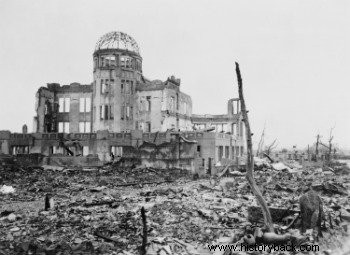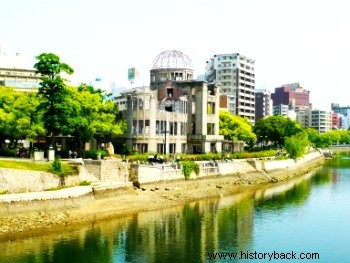Hiroshima Bomb is the name of the episode in which the first atomic bomb in history was used. Named Little Boy . In its wake, three days later, Fat Man was launched to another Japanese city, Nagasaki.
Abstract
Launched at 8:15 am on August 6, 1945 to the city of Hiroshima, its explosion caused the greatest number of fatalities. About 140,000 people died.
The atomic bomb was developed by scientists and engineers in a project called Manhattan. Before being released to Japan, it was tested on July 16th in the New Mexico desert, in the United States.
The world was at war. The Monday War World and, in an attempt to get Japan to surrender, the government of the United States of America dropped the nuclear bomb on the B-29 bomber called the Enola Gay .
The bomb contained uranium 235 in its payload, was about 3 meters long and weighed 4 tons. Named "Little Boy ”, was launched from a distance between 500 and 600 meters above the city of Hiroshima and destroyed it.
86% of people who were within 1 km of the explosion died instantly. Everything turned to dust and the bodies were disintegrated, so there were no corpses to count.
Bomb in Nagasaki
In Nagasaki, the bomb known by the name “Fat Man ” was launched three days later by the American B-29 bomber Bockscar , approximately 600 meters above the city.
It was 11:02 am on August 9, 1945. The launch of this second bomb was intended to force the surrender of Japan, which remained at war even after the launch of the 1st nuclear bomb.
The bomb dropped on Nagasaki contained a charge of plutonium 239, was just over 3 meters long and weighed about 4 and a half tons. The projectile killed 70,000 people and destroyed almost half of the city.
Finally, on September 2, 1945, Japan surrenders.
Consequences
Hiroshima was the 7th largest Japanese city and had 330,000 inhabitants, while Nagasaki had 175,000 inhabitants.
About 50,000 people died at the time of the explosion in Hiroshima - one of the largest Japanese cities at the time.
Shortly after the bombs exploded, it rained black rain that contaminated the water and soil.
In addition to instantaneous deaths and deaths minutes or hours after the events, nuclear attacks had many other serious consequences. The result was thousands of people infected, injured, burned and blinded.
Cancer, depression, genetic problems, physical deformations, sterility problems are some of the other problems caused by the effects of bombs.
Many people were left with permanent sequelae as a result of radioactive burns. For this reason, they were prevented from continuing their lives in society because they became victims of prejudice.
Years after the tragic event, the city still has high levels of radioactivity.
 Building destroyed shortly after the bomb was dropped on Hiroshima
Building destroyed shortly after the bomb was dropped on Hiroshima  The same building is now called The Atomic Bomb Dome or Hiroshima Peace Memorial as it is a symbol in memory of the victims of the tragic event
The same building is now called The Atomic Bomb Dome or Hiroshima Peace Memorial as it is a symbol in memory of the victims of the tragic event
In 2015, it was 70 years since the bomb was dropped, its survivors are called hibakusha.
Cities were rebuilt, but every year the victims of these catastrophes are remembered.
Today Hiroshima has more than one million inhabitants and Nagasaki about 400 thousand.
Did you know?
Vinícius de Moraes wrote the poem Rosa from Hiroshima in a reference to the dropping of the nuclear bomb on the city of Hiroshima.
The name of the poem derives from the pink appearance caused by the lifting of smoke from the bomb explosion.
In a tone of protest, the poem, which became music, was created in the 70's, a time when the military dictatorship was living in our country.
You also may if interest by:
- Hydrogen Pump
- World War II
- Consequences of World War II
- Questions about the Second World War
